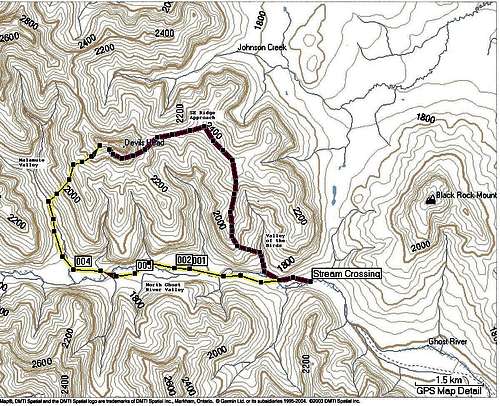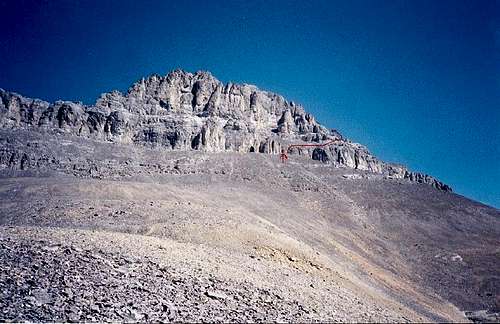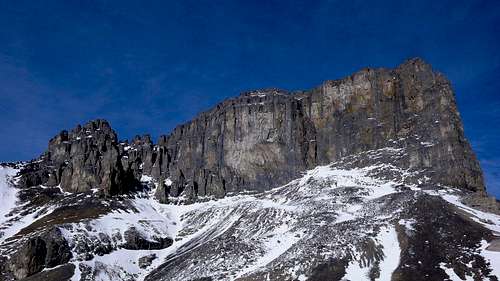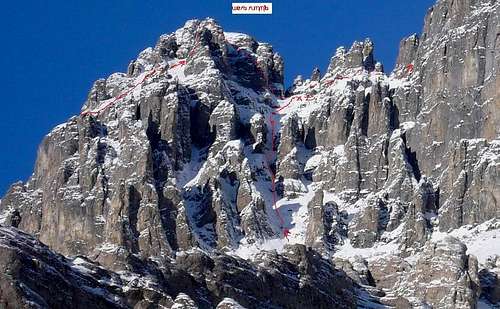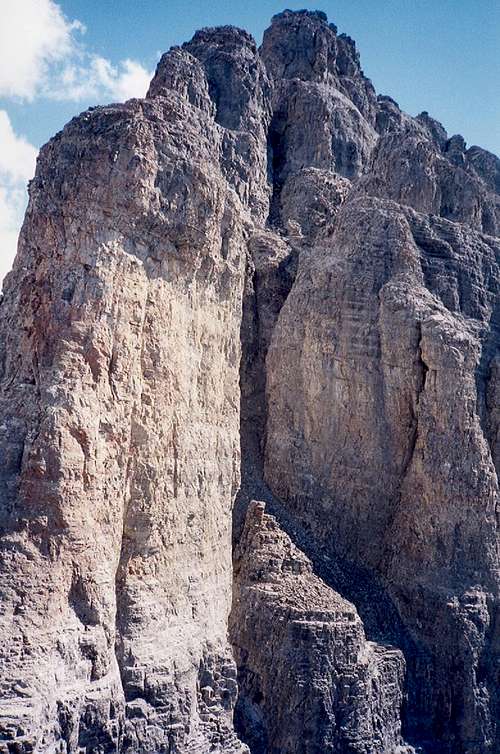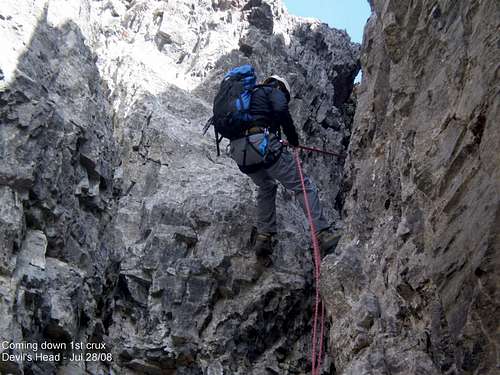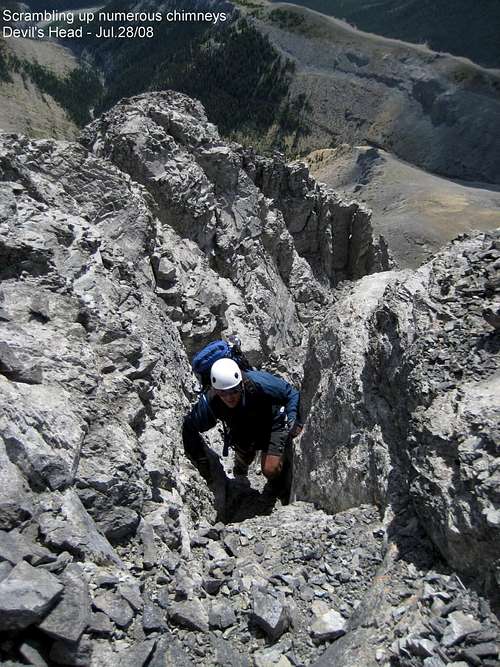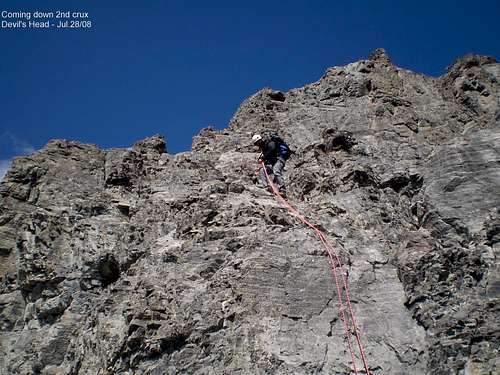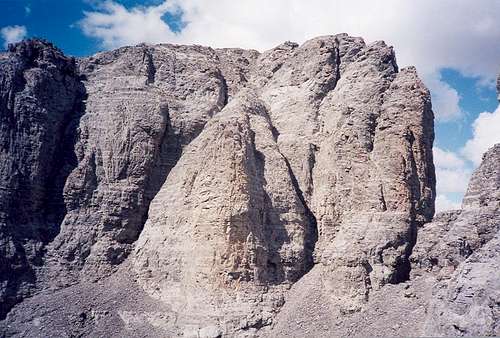|
|
Route |
|---|---|
|
|
51.34500°N / 115.265°W |
|
|
Mountaineering |
|
|
Spring, Summer, Fall, Winter |
|
|
One to two days |
|
|
5.4 (YDS) |
|
|
4 |
|
|
II |
|
|
Overview
The full West Ridge route with access/approach from the West by Malamute valley is not often done now because there now is easier and shorter access by the Valley of the Birds - recommended.North Ghost River valley has very steep canyon walls which necessitate 5 river crossings before Malamute Valley is reached. This area is all now Park or Designated Wilderness Area so motorized access is no longer allowed.
This trip involves 1150 m elevation gain(~3800ft) and about 18 km RT. One/two river crossing if Valley of Birds and 5 river crossings if by Malamute valley and a long slow drive in and out.
The Devil’s Head area is part of the overall Ghost -Forest Land Use Zone (FLUZ) and the mountain is now in part of the Don Getty Wildland Park which is beside the Ghost River Wilderness Area and Banff National Park.
To access the Ghost area, travel west from Calgary to Cochrane. Take highway 1A west for about 13.5 km and then turn North onto to the Forestry Trunk Road which also called Highway 40 and Secondary Road 940. Follow it for about 22.7 km to a gated gravel road on the West side. The road is about 100 – 200 m past a major curve to the North and the turn off for Richards Road. The road has a large gate made from metal pipe and it is on the South side of the Bar Cee Ranch. Close the gate and watch your speed as there are free ranging cows in the summer.
The gravel road is used and maintained by several commercial companies but it is open to the public. It is rough and narrow in spots and crosses one poor bridge in various state of repair or drive through the stream on the North side. Stay on the main road for about 16.5 km to the Big Hill. There are views of Devil’s Head and the North and South Ghost valleys from a gassy parking area to the right of the road. The road down the hill is steep and can be heavily rutted and covered with large rounded river bed rock. In the winter if can be snow drifted or icy. If you are not driving a 4 x 4 it may be worth a walk and look to be sure you can get back up.
There are no services or phone reception out here. At the bottom of the hill there is an area to the left (South) where people camp. The trail to the left leads to Devil’s Gap and the South Ghost. The trail to the right leads haphazardly across the gravel flats and river bed to the North Ghost area. Ignore the turnoff to Black Rock mountain (interesting hike to an old abandoned fire lookout) and travel along a canal and over a bridge. Park near Sentinel Crag before the river crossing at the entrance to the mountains (Marker 39). There is an official government ban on crossing this river here or upstream of Marker 39 with vehicles to protect Brown Trout which spawn in the gravel beds of the river.
This trip involves 1150 m elevation gain(~3800ft) and about 18 km RT. One/two river crossing if Valley of Birds and 5 river crossings if by Malamute valley and a long slow drive in and out.
Area Access
Devil’s Head may be in plain view of over a million people but is still remote by modern standards. The base of the mountain is guarded by a set of cliffs which limit access from several directions and the only road into the area is a poorly maintained commercial gravel road. The last part of the road is best accessed with a 4x4. The original route to the base of the mountain involved following the North Ghost river west past the south side of the mountain to Malamute valley and approaching the mountain from the west. The North Ghost valley has steep walls and five river crossing are required to access Malemute valley. The shortest current access involves one/two river crossing on foot and then scrambling up a steep side valley to reach the mountain from the SE.The Devil’s Head area is part of the overall Ghost -Forest Land Use Zone (FLUZ) and the mountain is now in part of the Don Getty Wildland Park which is beside the Ghost River Wilderness Area and Banff National Park.
To access the Ghost area, travel west from Calgary to Cochrane. Take highway 1A west for about 13.5 km and then turn North onto to the Forestry Trunk Road which also called Highway 40 and Secondary Road 940. Follow it for about 22.7 km to a gated gravel road on the West side. The road is about 100 – 200 m past a major curve to the North and the turn off for Richards Road. The road has a large gate made from metal pipe and it is on the South side of the Bar Cee Ranch. Close the gate and watch your speed as there are free ranging cows in the summer.
The gravel road is used and maintained by several commercial companies but it is open to the public. It is rough and narrow in spots and crosses one poor bridge in various state of repair or drive through the stream on the North side. Stay on the main road for about 16.5 km to the Big Hill. There are views of Devil’s Head and the North and South Ghost valleys from a gassy parking area to the right of the road. The road down the hill is steep and can be heavily rutted and covered with large rounded river bed rock. In the winter if can be snow drifted or icy. If you are not driving a 4 x 4 it may be worth a walk and look to be sure you can get back up.
There are no services or phone reception out here. At the bottom of the hill there is an area to the left (South) where people camp. The trail to the left leads to Devil’s Gap and the South Ghost. The trail to the right leads haphazardly across the gravel flats and river bed to the North Ghost area. Ignore the turnoff to Black Rock mountain (interesting hike to an old abandoned fire lookout) and travel along a canal and over a bridge. Park near Sentinel Crag before the river crossing at the entrance to the mountains (Marker 39). There is an official government ban on crossing this river here or upstream of Marker 39 with vehicles to protect Brown Trout which spawn in the gravel beds of the river.
West Ridge Access
Overview of access routes. The Yellow route is access for North Ghost and Malamute Valley and the purple is the access for the Valley of the Birds.Malamute Valley Access
Park the vehicle at Marker 39 before the first river crossing and travel west in the North Ghost valley. After crossing the North Ghost river 5 times you eventually you cross a stream coming in from Malamute valley which runs N-S on the west side of DH. Malamute valley trail is about 5 km after first river crossing and the trail is on the west side of the stream that you cross that runs out of Malamute valley.
The river crossings are normally 2 feet deep or less by late summer but they are deeper later in the day or if it rains. We used trikes on the second and third ascents and had problems such as floating down the river until we could hit a sand bar to get out. On the last trip on the way in, my trike floated and then rolled and it drowned/died. We left it beside the river and then dragged it through the river on the way out.
The river crossings are not marked and the trail is hard to follow. Some bits of old road some useful, but some are not as they lead nowhere. There are lots of old 4x4 tracks but they are easy to lose on the gravel bars. First two crossings are deepest and to south side of valley, the next is in the middle with a poor angle - drive in right side of river beside the right bank then angle left when forced into deeper water and aim upriver for shallower gravel beds. Stick to gravel beds for .5 km till trail leads to old road in trees to left. Next crossing is also in middle of valley but better to go to right and then hit old road in trees. Note that this is all now Park or Wilderness area and motorized vehicles are no longer allowed.
There are several good camp spots near the entrance of Malamute Valley.
From the camp spot travel 30 minutes along valley floor and then up the left side of a small drainage(may be a small cairn on a big rock) on the East side of the valley and soon hit bits of trail in the scree. After the trees leave the descent trail and angle to the left to a small ridge to avoid the scree. Top out on a main North-South ridge which leads up to base of the walls on the upper part of the mountain on the SW side of the West ridge. A climbers trail leads to low spot or weakness in first wall. There is a faint trail that comes around from the North side and which heads East along the South side. This trail from the West would also provide access to the steep South scree gully route which is now mainly accessed from the SE.
Park the vehicle at Marker 39 before the first river crossing and travel west in the North Ghost valley. After crossing the North Ghost river 5 times you eventually you cross a stream coming in from Malamute valley which runs N-S on the west side of DH. Malamute valley trail is about 5 km after first river crossing and the trail is on the west side of the stream that you cross that runs out of Malamute valley.
The river crossings are normally 2 feet deep or less by late summer but they are deeper later in the day or if it rains. We used trikes on the second and third ascents and had problems such as floating down the river until we could hit a sand bar to get out. On the last trip on the way in, my trike floated and then rolled and it drowned/died. We left it beside the river and then dragged it through the river on the way out.
The river crossings are not marked and the trail is hard to follow. Some bits of old road some useful, but some are not as they lead nowhere. There are lots of old 4x4 tracks but they are easy to lose on the gravel bars. First two crossings are deepest and to south side of valley, the next is in the middle with a poor angle - drive in right side of river beside the right bank then angle left when forced into deeper water and aim upriver for shallower gravel beds. Stick to gravel beds for .5 km till trail leads to old road in trees to left. Next crossing is also in middle of valley but better to go to right and then hit old road in trees. Note that this is all now Park or Wilderness area and motorized vehicles are no longer allowed.
There are several good camp spots near the entrance of Malamute Valley.
From the camp spot travel 30 minutes along valley floor and then up the left side of a small drainage(may be a small cairn on a big rock) on the East side of the valley and soon hit bits of trail in the scree. After the trees leave the descent trail and angle to the left to a small ridge to avoid the scree. Top out on a main North-South ridge which leads up to base of the walls on the upper part of the mountain on the SW side of the West ridge. A climbers trail leads to low spot or weakness in first wall. There is a faint trail that comes around from the North side and which heads East along the South side. This trail from the West would also provide access to the steep South scree gully route which is now mainly accessed from the SE.
Valley of Birds Access - also see South Gullies Route Description
Park the vehicle at Marker 39 and cross the river one/two times. Enter the Valley of the Birds which is the first valley/canyon entrance on the right as you travel West in the North Ghost Valley.
Find a trail on the left hand side of the canyon which gains a long N-S ridge which leads to a West ridge which leads up to the East face of Devil's Head.
Find a trail on the left hand side of the canyon which gains a long N-S ridge which leads to a West ridge which leads up to the East face of Devil's Head.
Route Description
Approaching West Ridge from Malamute Valley -If coming from Valley of Birds - go West past base of South Gullies and follow trail up and around to base of West walls.
Overview of upper part of West ridge route from SE.
There were at least four ways to go. To the left is a 5.5 friction ledge which leads to an ugly loose chimney which we followed part way on our first try but it is longer and not necessary, despite cairn. The best route is to go right around a buttress and up across angled scree slopes and up to base of a larger chimney alongside a towering right-hand wall. The smaller chimney to the left leads to harder face climbing and is the rappel route off the West summit. The neat window in the wall to the right gives a good view of the main peak but leads down to downsloping slabby ledges with no protection.
The main chimney has a 3-4 m 5.4 section which is part body jam with one hand and foot on the smooth right wall which is similar to moves on lower chimney which leads to Un-named(Pumpkin) and Kings Chimney on Yamnuska. The angle eases off and you intersect with the high point of the West ridge which is the West Summit.
View of Main Summit from West summit with route marked.
The view of the main peak is stunning as the west ridge drops 50 m (150 feet) and degrades into 20 to 40 m pinnacles which lead to the main summit block which has a complicated face, vertical sides and is 150 – 200 m higher. Take a good look at this because it looks different with your face up against it. Note the single 25 m pinnacle to the right away from the main ridge as you will go between it and the others. On the main face, the chimney that leans right is the one you want for the lower half.
Scramble down on loose rubble to the top of a buttress between the main west ridge and the side ridge you came up. As you look down to the saddle, there is a chimney on each side of this buttress. The left one has horn for a rappel sling. Rap or downclimb down 30 m to base of the chimney which is on a rubble ledge at the base of the pinnacles. You need to climb this chimney to get back out and it had some 5.3 to 5.4 moves in it and no protection.
Move 70 m across the rubble and past the top of the steep narrow gullies which come in from the South, to a gully the leads up to the saddle between the isolated pinnacle and the main ridge. Go over the saddle (cairn) and across ledges to a gully up to left that leads to base of two chimney systems.
Looking up at chimneys on Main Summit from the base of Pinnacles in the Saddle.
The Right hand chimney has a partly overhanging chockstone at 4 -5 m but it is the one because you can see a chained rappel station up on the right-hand wall above the chockstone. Climb the chockstone directly or climb the left chimney for 3-4 m and then traversed on face around to above chockstone.(5.3/5.4 and no protection- first crux)
Rappelling back over the chockstone. Photo courtesy of Phil Schreiner.
Climb up for 30 m to where chimney splits. Left chimney leads up to very exposed face climbing ( old sling) but better to continue up right one which leads to the same large sloping rubble ledge.
Climbing in the upper part of the chimney. Photo courtesy of Abhi Maneriker.
There was a cairn which was marked with flagging tape to mark the top of this chimney for later.
Angle up right 70 – 100 m up to base of next wall which has options but we moved right along wall past a small pinnacle and around for 30 m to an easier spot on the wall. Face climb the wall 5.3/5.4 (second crux)angling up left for 10 m to a ledge.
Rapelling the slabby wall. Photo courtesy of Phil Schreiner.
This is also marked with a cairn as it is hard to see where to start down climbing on the way down. Move right and up a loose gully which goes left then right and up onto easier ground which is the summit ridge (cairn).
Walk 200m to the summit cairn and enjoy the view which includes the Calgary office buildings on the horizon.
Downclimb everything except the lower part of the chockstone chimney (short rap) and then climb up west ridge and rap off it or downclimb the South Gullies route.
West Summit from saddle on the way out. We climbed back up the RH of the two left leaning chimneys.(5.3/5.4 with no protection)
Essential Gear
Alpine climbing gear with a small rack and a hammer since minimal protection is required.I drove a better piton and backed it up with a sling to rap off the West Summit on the way out.
Less gear required if downclimb South Gullies


